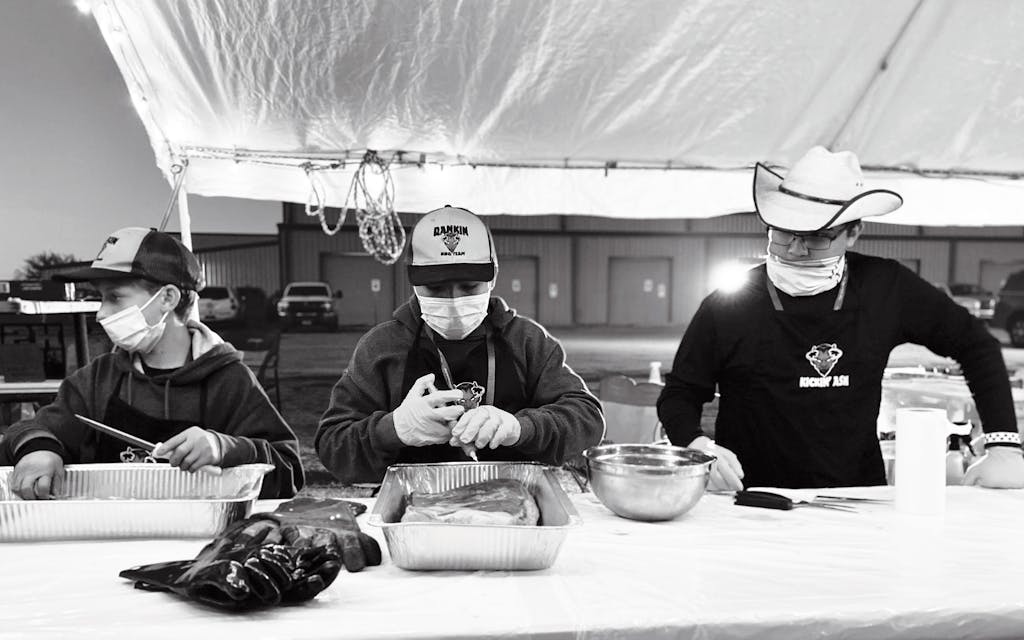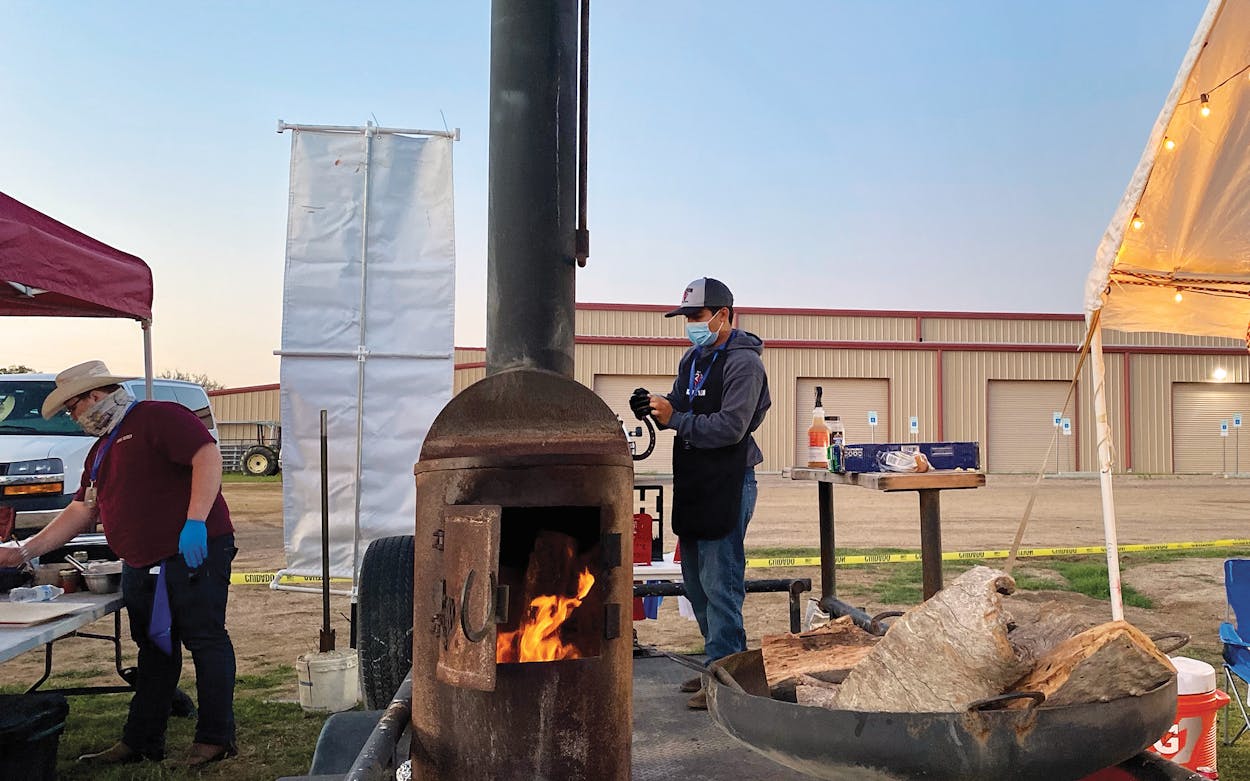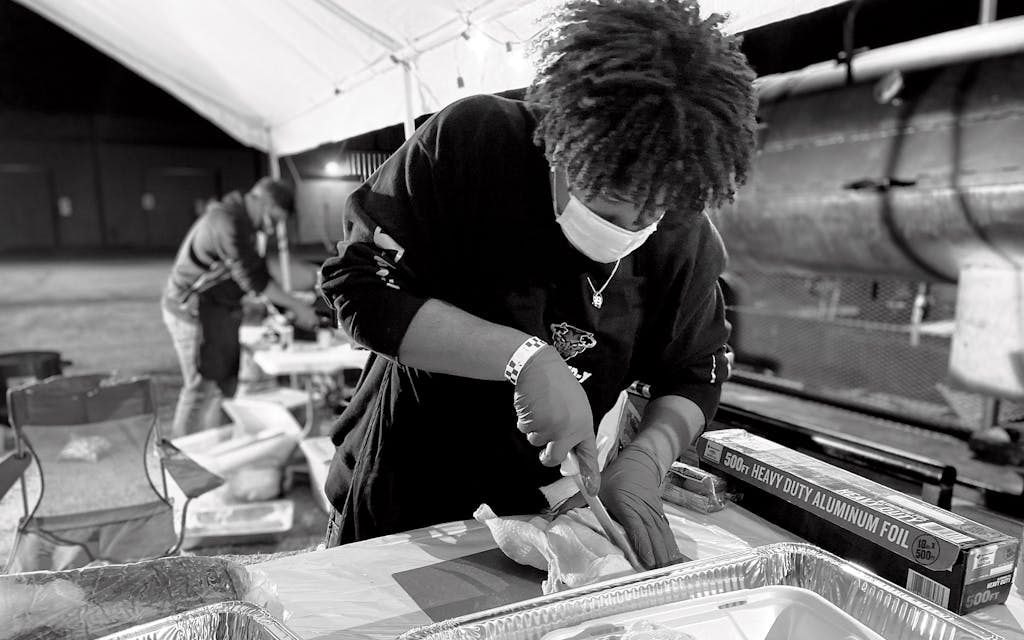Fifteen-year-old Parker Prewozniak is the youngest student on the Rankin High School barbecue team, and he looks it. Standing at least three inches below his teammates on competition barbecue team Kickin’ Ash, Prewozniak hunches over a rack of pork ribs. He’s trying to remove a layer of thick membrane that prevents the meat from fully absorbing the desired smoky flavor. He holds down the ribs with one blue-gloved hand while pinching a piece of the connective tissue attached to the underside of the ribs with the other, and tries to tear it off with one swift motion. After a few unsuccessful attempts, he grabs a paper towel to help better grip the slippery tissue.
“Tearing off the membrane is pretty challenging,” says Prewozniak. “It’s probably one of the hardest parts of the whole thing.” While he’s preparing the ribs, Rankin sophomore Andres Reyes stands next to him, injecting seasoned beef broth into a slab of beef brisket.
“It helps keep it moist and adds to the internal flavor,” Reyes tells me, not taking his eyes off the meat, intent on sticking the needle in just the right place before moving it slightly to take another jab.
“Don’t turn the brisket too much, it’ll get mushy,” yells one of the team’s mentors (and mothers) from the sidelines.
It’s 6 a.m. at Texas’s State High School BBQ Championship, and Prewozniak and his teammates have already been working for an hour and a half. Today, 61 teams from schools across the state have gathered in Llano to spend the next ten hours prepping, spicing, smoking, grilling, and baking in hopes of taking home the trophy, along with $6,000 in scholarship money. After a year of hauling smokers all over Texas, it all comes down to the state championship.
On the last Saturday in April, tents filled with smokers, grills, plastic-covered tables, and banners imprinted with high school mascots transform the John L. Kuykendall Event Center and Arena parking lot into an open-air competition-cooking kitchen. Setup begins promptly at four thirty. Groups of half-asleep students heave heavy coolers out of truck beds and trailers and walk them over to their assigned tents. A teenager mindlessly tightens the hood of his Red Devils sweatshirt to warm his face from the 56-degree morning as he goes back to the truck to grab another armful of wood.
Before the parking-lot lights are turned on, students use their own light sources—camping lanterns, headlamps, flashlights, headlights of strategically parked trucks—in order to see their cooking stations. Later in the day, parents and coaches will crowd the sidelines making noise, but for now all I hear are boots shuffling over loose gravel and murmurs of conversation asking how many bags of charcoal are needed for the morning. Occasionally, the thud of a teenager dropping a sixteen-gallon plastic container filled with towels, aluminum pans, knives, spray bottles, foil, and bowls cuts through the silence.
At ten minutes to five, the buzz from generators begins to fill the air and students start loading wood into smokers that range from brand-new, kamado-style grills (think Big Green Egg) to rusty charcoal smokers. When the clock strikes five, an iron triangle hit with a mallet indicates it’s time for pitmasters to light their fires for the official start of the competition. With fires lit in the smokers, the opening prayer complete, and the cuts of meat selected, the student pitmasters go to work preparing the meat. Prewozniak flips the rack of ribs upside down to start working on the membrane.

The student competition started six years ago. Chuck Schoenfeld, a pitmaster with forty years of experience on the competition barbecue circuit, teamed up with a culinary arts teacher at Burnet High School to host a competition between the school’s agriculture and culinary arts students. The event was such a success that Schoenfeld created High School BBQ Inc. to expand into statewide competitive barbecue cook-offs. The nonprofit organization now hosts a series of local and regional competitions throughout the school year, and the top teams advance to the state championship each spring.
“As a competition cooker, I didn’t see the younger kids getting involved anymore; it was just us older guys that have been doing it for a long time. I wanted to get the younger crowd involved,” says Schoenfeld.
Teams of up to five students prepare dessert, beans, chicken, pork ribs, and the king of Texas barbecue—beef brisket. Each category requires different cooking skills: dessert calls for an understanding of the chemistry of baking, beans need a knowledge of flavor and seasoning, and brisket asks for fire-management skills and a hefty dose of patience. The judges—local city council members, county commissioners, police officers, and more (some picked by Schoenfeld, and others who reached out to volunteer when they heard a whole lot of barbecue was coming to town)—rate each plate on appearance, smell, and taste. Winners are awarded prizes in each of the five food categories, but the coveted prize is the overall State High School BBQ Grand Champion, which comes with scholarship money for students to continue their food educations. The Auguste Escoffier School of Culinary Arts, a culinary school in Austin, awards each member of the winning championship team a $5,000 scholarship. HSBBQ Inc. also gives each teammate a $1,000 scholarship to the school of their choice.
Teams with names like Beef Battalion from O’Donnell, Up In Yo Grill from Katy, and Silence of the Hams from Uvalde have congregated in the tiny Hill Country town of Llano for a chance at the title. Unlike in high school sports, schools from the state’s largest cities and suburbs compete with schools from the smallest dots on the map, with eighty-student schools pitted against three-thousand-student schools. Regionals, which split the state into eleven segments, gave students the chance to prepare for the state competition.
“Where we grow up in Texas [determines] how we eat our meats and the flavors we put on them,” says Marnie Schoenfeld, Chuck’s wife and a judging facilitator, whose tasks today include setting up the judging tables and organizing the trays of food. “Certain regions only want salt and pepper, certain regions want a sweet glaze on the ribs, others want dry ribs. A grand champion of brisket in West Texas might go to South Texas a few months later and not even place.”
I’m spending the day following the students from Rankin—an eight-hundred-person town deep in the Permian Basin—who were rumored as the ones to beat coming into the competition. The school has three teams: the Red Devil Smokers for seniors, Hot-N-Red-Y for juniors, and Kickin’ Ash for sophomores and freshmen. All three swept the brisket and chicken categories during the regionals.
“These kids have worked their rears off,” says Rankin High School barbecue coach Robbie McClure, the school’s shop teacher. “They have come a long way from where they started.”

Team coaches and mentors are not allowed to enter the cooking station. They must stand behind a perimeter of caution tape and offer guidance from the sidelines, so the adults set up foldable camping chairs along the perimeter of their team’s tents and settle in for a long day. Occasionally, students carry plastic spoons overloaded with beans or sauce to the sidelines for a taste or to get a second opinion on spice levels.
McClure rarely sits down. He circles around the tables, keeping an eye on the clock, tabulating the changing weather conditions, and reminding the students to check the meat. When the breeze picks up at 8:30, he walks around to each team instructing them to “check your fire pits; make sure they’re not getting too hot.”
Most of the Rankin students first learned about the barbecue team from McClure’s welding class. When a Facebook post about the high school competitions landed on McClure’s feed in 2018, he suggested to other teachers that the school form a team. “Rankin is the type of town where practically everyone has a smoker in their backyard, so we thought our kids would be well suited for it,” says Carrie Templeton, a Rankin High School teacher, team mentor, and mom.
Their first competition was a complete disaster. The team members cooked the way they would in a backyard setting, she explains, but cooking for a competition means the pitmasters have to pay close attention to appearance and plating. Realizing they needed professional help, McClure invited Bernie Phillips, a local veteran of professional cooking competitions, to teach the students how to cook for sport. Now Phillips travels with the team, and is one of the mentors standing on the sidelines and giving advice, like where on the body to take a chicken’s temperature (in the crook of the elbow) and when to pull down the temperature of the grill (any time it reaches 300 degrees).
The barbecue competitions provide high school students with another type of after-school activity. “Not all these kids are going to be athletes,” says Templeton. “I tell them they can carry this on to use for the rest of their lives. It is something they will always be able to share with their friends and families.”
Students turn in their food at a few scheduled times throughout the day, but while meat sits in the smokers, there are long moments of downtime. The Rankin boys kill time by scrolling through social media while sitting in camping chairs, or strolling through the competition grounds to find teens from other schools to flirt with. Several times during the afternoon, senior Orryn Bond strums a guitar and sings while walking around the cooking station.
The final plate, the brisket, is due at 3 p.m. Members of the Rankin squad carefully place seven perfectly sliced pieces of brisket into a Styrofoam takeout box and wipe the sides clean with a towel before closing the lid. The box is then sent indoors to a judging table, where, due to COVID restrictions, judges rank the meat for aroma, appearance, and taste in private.
In the end, none of the Rankin teams take home the grand prize. Hot-N-Red-Y places eighth, Kickin’ Ash scores tenth, and Red Devil Smokers lands at thirteenth. There’s a major victory, however: Andres Reyes’s brisket takes first place in the brisket category. The championship title is a tie between two teams: the Smoking Eagles from Atascocita High School near Houston and Bulldog FFA BBQ from Burnet High School.
“At our previous competitions we were always so close to winning first place, but would end up in third or fourth place,” says Jacob Martinez, a junior at Atascocita. “We knew sooner or later the stars were gonna align and we would eventually be lucky enough to be named the Texas High School BBQ Grand Champions.” The junior team will be back next year with new recipes and improved smoking techniques, he says, with hopes to win it all again.
With the 2020–21 season in the books and what looks like the winding down of the pandemic, Chuck Schoenfeld predicts the high school barbecue competitions will continue to grow. His goal for next year’s state championship is one hundred teams. With so many high school students learning the best ways to smoke meat, the future of Texas barbecue looks bright.
- More About:
- Llano







